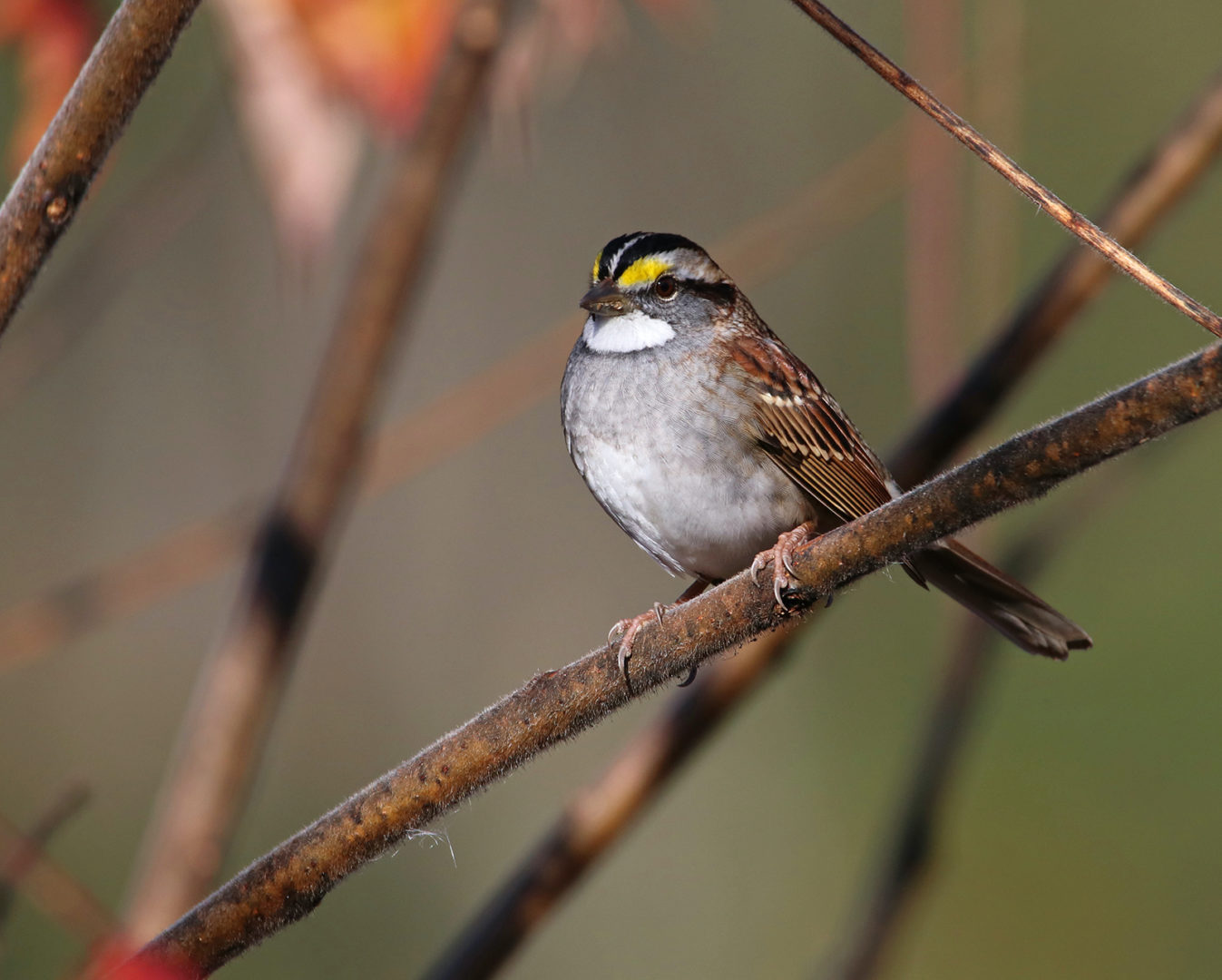“Oh sweet Canada, Canada, Canada” is the mnemonic often associated with the easily-recognized song of the white-throated sparrow, a common winter resident of Pennsylvania and states to our south. Flocks usually arrive here from Canada in October and don’t leave until late April or early May. While some species only sing while defending breeding territories, it is not uncommon to hear white-throated sparrows singing all winter long.
When compared with most sparrows, the white-throated is larger and has a longer tail. It is the only sparrow that we are likely to see in central Pennsylvania with a large white throat patch. It also has a distinctive head — striped in black and white (sometimes brown and tan) with yellow lores — a small patch of feathers in front of each eye. The birds have brown backs, gray breasts, and sport two faint, white wing bars. The white-throat’s scientific name, Zonotrichia albicollis, makes reference in Latin to its striped head and white neck.
Males have similar coloration to females, but you would never guess that by studying paired birds. Two color morphs of white-throats occur in both sexes — the distinctive “white striped” morph described above and a “tan striped” morph that has a duller tan and dark brown striped head and sometimes has a faintly-streaked breast.
The “white striped” morph of either sex is the more aggressive and territorial. While the tan striped birds are better at nesting and care of the young. Therefore, mixed pairs have complimentary traits. Experts disagree as to exactly how the choice is made, but according to the Cornell Lab of Ornithology, “white stripes” pair with “tan stripes” of the opposite sex 96 percent of the time.
The white-throated sparrow nests from central Canada, just south of the tree line, to the northern United States. According to breeding bird surveys, nesting pairs are most abundant in a strip of territory that extends from central Alberta, east through southern Ontario, and into Maine. North-central and north-eastern Pennsylvania are at the southern edge of their breeding range, with a few birds reported as “confirmed nesters” as far south as Mifflin County.
Forested openings with shrubby cover near wetlands are the preferred nesting habitat for white-throats. Specific nesting sites are along the edges of marshes, beaver dams, streams and brushy areas.
Their ground nests are constructed from grass, fern stalks, small roots and twigs, and often lined with deer or horse hair. The nest is usually concealed under ferns, logging slash, briars or brush.
In late May or early June, the female sparrow lays three to five pale blue or bluish-green eggs, which are often blotched with reddish brown. The eggs hatch following a 12- to 14-day incubation. Young fledge the nest less than two weeks after hatching.
During the summer, white-throated sparrows feed on insects, spiders and millipedes, while they are mainly seed eaters in winter. White-throats frequently visit bird feeders, where they prefer to feed on the ground under the feeder. In the spring, white-throats add the buds of maple, oak, apple and crabapple to their diet.
Because of their preferred habitat, it should be no surprise that the northern harrier is the number one predator of adult white-throated sparrows. They also fall prey to the kestrel and the sharp-shinned hawk. Nests are raided by skunks, raccoons, snakes and other ground predators, particularly in the southern part of their breeding range.
Another unique aspect of white-throated sparrow behavior is that their familiar song is evolving. Research published in “Current Biology” in 2020 documents that their song is changing. A shortened version of their song was first documented in western Canada in 1999. During the past 20 years it has spread from British Columbia eastward over 1,800 miles across north America and is now quite common in growing parts of their range. The new song sounds more like “Oh sweet Cana, Cana, Cana.”
According to Centre County birder Nick Bolgiano, who authored the section on the white-throated sparrow in the second “Atlas of Breeding Birds in Pennsylvania,” the southern range of breeding white-throated sparrows appears to be contracting northward and the species has an uncertain future in Pennsylvania and southern New York. The number of survey blocks containing nesting birds here has decreased significantly.
Consider joining in for the 122nd Audubon Christmas Bird Count, a citizen science project. It is occurring on specific dates through Jan. 5, 2022. I am sure that many of the participants will see and hear the attractive white-throated sparrows.
Mark Nale writes about the outdoors for the Centre County Gazette. This column appears in the Dec. 23-29 edition of the Gazette.



